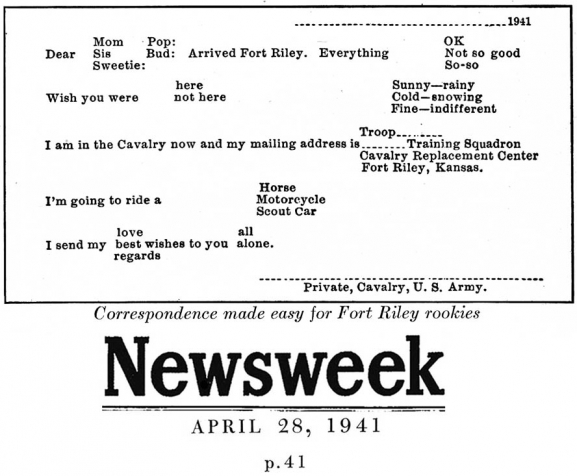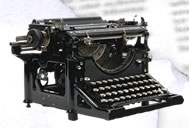Another look at the M-2 Half Track and the training of their five-man crews at Fort Hood, Texas. We got a kick learning that these men were not simply trained to fire their 37 and 75 mm. mounted guns, but also instructed in all other manner of tank fighting methods:
"Another little trick they master is the construction of a "sticky grenade"; a white sock filled with TNT, soaked in heavy axle grease to triple it's detonating power. This sticks like glue; and if it explodes near the tank's ventilators -- that's all, brother."
Click here to read about the TD units that fought at the Battle of the Bulge.
The attached article weighs the way infantry basic training was conducted at the beginning of the war and how it had changed as the war progressed, evolving into something a bit different by 1945. The training period was originally a 13 week cycle in 1941, yet in time after carefully watching the soldiers in the field and finding that infantrymen needed a broader understanding of the tools at hand, the infantry training at Camp Wheeler, Georgia, had been extended an extra two weeks. One of the obvious factors involved a far wider pool of combat veterans to rely upon as instructors.
Five years after the war, many infantry replacement camps had to reopen...
You might also like to read this article about W.W. II cavalry training.
Statistical data concerning the U.S. Army casualties in June and July of 1944 can be read in this article.
Erroneously believing that their new recruits were lacking in a sufficient amounts of anti-Teutonic zeal, the brass-hats in charge of the U.S. Army training gulag at Fort Knox, Kentucky decided to employ roving bands of faux-Nazis to frustrate and bedevil the men in training. The hard-charging editors of YANK belittled the scheme.
Which Hollywood actors received draft deferments?
"Training for combat, according to veterans in Italy, should be a hell of a lot more realistic and a hell of a lot more thorough."
"'They oughta learn them guys' is that favorite beef you hear from combat veterans when they talk about replacements who have just joined their outfits...the average replacement doesn't know enough about the weapons an infantryman uses. 'He usually knows enough about one or two weapons...but he should know them all. He may know how to use and take care of the M1 or carbine, but if you need a BARman or machine-gunner quick, you're up a creek.'"
Statistical data concerning the U.S. Army casualties in June and July of 1944 can be read in this article.
Originally published in the
Stars & Stripes of the U.S. Marine Corps,
The Leatherneck, this is an interesting eight page article illustrated with fifteen photographs regarding the dramatic growth in that institution that took place in the immediate aftermath of the Pearl Harbor attack.
Click here to read a CLICK MAGAZINE article about the Marines of W.W. II.
Articles about the W.W. I Marines can be read HERE...
Read what the U.S. Army psychologists had to say about courage in war.
Read what the editors of YANK MAGAZINE thought about the Marine Corps Magazine, LEATHERNECK...
Read about the Women Marines of W.W. II HERE.

For the Americans, World War II was just four months old when these three color pictures appeared depicting the most up to date (and economical) methods used in the training of Stuart Tank gunners.
World War II terms such as tail gunner, waist gunner and belly gunner are no longer a part of our vocabulary; they are uttered, if at all, about as often as the word blacksmith. However, since you found this website, there is a good chance that you use these terms more often than most - which means you'll appreciate the attached color photo-essay from 1943 illustrating how vital W.W. II Allied aerial gunners were in winning the air war over Germany and Japan.
One month after this article was seen on the newsstands, America would be reading a good deal about the U.S. Army Assault Climbers when they thirsted to read further about those hardy lads who climbed the steep cliffs at Point du Hoc on D-Day; but in May of 1944, the term was new to them. The article is well illustrated with two color images and a brief explanation as to what was involved in the training of those lucky souls who were charged with the task of learning how to climb the rocky terrain held by the Fascist powers.
Read what the U.S. Army psychologists had to say about fear in combat.
We are not sure how wide-spread boxing exercises were among all the U.S. Army infantry training camps during W.W. II, but the attached photo-essay will cue you in to the fact that it was mighty important at Camp Butner in 1943.
"Up by bugle at 5:45 in subfreezing temperature. Breakfast - boiled oatmeal, French toast and syrup, toast, jam, coffee. At 7:30 began 'psychological test' for mental alertness (typical question: An orange is a broom, bat, flower, or fruit?). Received complete uniforms. Try-on period after lunch resulted in many misfits, much swapping and revival of old crack about there being only two sizes in the Army - too big and too small..."
Click here to read about what was involved in training a WAAC.
